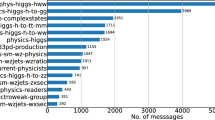Abstract
In the paper, we first present an approach to extract social networks from message boards on the Internet. Then we propose communication gaps based on structural features of the social networks as an indicator of understanding the state of communication. After we classify 3,000 social networks into three types of communication, i.e., interactive communication, distributed communication, and soapbox communication, we suggest communication gap management to identify the types of communication, the roles of individuals, and important ties, all of which can be used for drawing up a plan for realizing fertile community.
Similar content being viewed by others
References
Bavelas A (1950) Communication patterns in task-oriented groups. J Acoust Soc Am 22:725–730
Freeman LC (1978) Centrality in social networks. Soc Netw 1:215–239
Goldberg DE, Welge M, Llorà X (2003) DISCUS: distributed innovation and scalable collaboration. In: Uncertaion settings, IlliGAL Report No. 2003017
Goldberg DE (2002) The design of innovation. Kluwer
Granovetter M (1973) The strength of weak ties. Am J Sociol 78:1360–1380
Krackhardt D, Hanson JR (1993) Informal networks: the company behind the chart. Harvard Business Rev July-August:104–111
Matsumura N (2003) Topic diffusion in a community. In: Ohsawa Y, McBurney P (eds) Chance discovery. Springer, Berlin Heidelberg Newyork, pp 84–97
Matsumura N, Miura A, Shibanai Y, Ohsawa Y, Nishida T (2005) The dynamism of 2channel. J AI & Soc 19:84–92
Milgram S (1967) The small world problem. Psychol Today 1:61–67
Moreno JL (1934) Who Shall Survive?. Beacon House, Beacon
Ohsawa Y, Soma H, Matsuo Y, Matsumura N, Usui M (2002) Featuring web communities based on word co-occurrence structure of communications. In: Proceedings of WWW2002, pp 736–742
Ohsawa Y, McBurney P (eds) Chance discovery. Springer, Berlin Heidelberg Newyork
Rogers EM (1962) Diffusion of innovations, 4th edn. Free Press, New York
Scott WR (1992) Organizations: rational, natural, and open systems. Prentice-Hall, Englewood Cliffs
Tyler JR, Wilkinson DM, Huberman BA (2003) Email as spectroscopy: automated discovery of community structure within organizations (Preprint http://www.lanl.gov/arXiv:cond-mat/0303264)
Wallace P (1999) The psychology of the internet. Cambridge University Press
Author information
Authors and Affiliations
Corresponding author
Rights and permissions
About this article
Cite this article
Matsumura, N., Goldberg, D.E. & Llorà, X. Communication Gap Management for Fertile Community. Soft Comput 11, 791–798 (2007). https://doi.org/10.1007/s00500-006-0121-3
Published:
Issue Date:
DOI: https://doi.org/10.1007/s00500-006-0121-3




